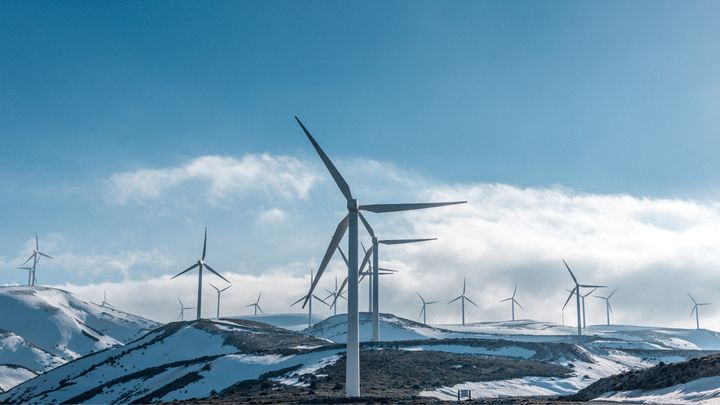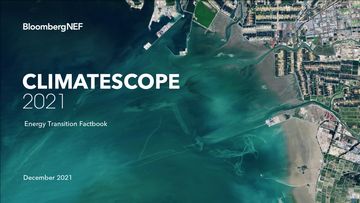
Power
4.4%
Growth in global renewable energy investment in 2020
-10%
Drop in renewable energy investment in emerging markets in 2019-2020
314GW
New wind and solar capacity added in 2020
Global renewable energy asset finance inched up 4% in 2020
Asset finance for renewable energy projects rose 4.4% in 2020 from the year prior, but investment in such projects has remained more or less level over the past five years. The average annual growth rate since 2015-2016 has been 1.4%, compared to more than 13% during the first half of the decade. However, as clean energy equipment prices plummet, stable investment levels actually reflect more capacity getting built.
Wind and solar represented 95% of the renewable energy investment received globally in 2020. Wind accounted for 54% of the total with $153 billion, while solar received 41%, or $114 billion.
Renewables investment shifted sharply back to developing nations in 2020
The share of renewable energy investment directed to developing nations plummeted to 52% in 2020 – the lowest level since 2014. This was down from 59% in 2019 and a peak of 63% in 2017. Emerging markets account for nearly two-thirds of the global energy sector emissions and have been recording the majority of renewable energy investment since 2014. But the abrupt shift highlights that international support for emerging markets will be pivotal to ensure a successful global race to zero.
“High” and “upper middle income” designated countries accounted for 93% of renewable energy investment in 2020.”Lower middle income” countries, including Vietnam, Morocco and Philippines, accounted for just 6.5%, while “low income” countries, including Uganda, Ethiopia, Guatemala, and many more received just 0.4% of the total.
Renewable energy investment jumped 24% in rich nations, but plummeted 9% in emerging markets
While developed nations saw asset finance for renewable energy projects jump 24%, from $109 billion in 2019 to $136 billion in 2020, emerging markets saw levels fall 9%, from $159 billion to $145 billion. Investment remains 7% higher in developing nations, but the gap is far smaller than in previous years.
Wind is the main technology for renewable energy investment in both developed and developing markets, with 51% and 58% of the total, respectively. Solar follows with 44% of the total in developed nations and 37% in emerging markets.
Lockdowns impacted OECD and non-OECD countries differently
Generation in developing (non-OECD) nations continued to rise in 2020 despite the pandemic, but slipped in wealthier (OECD) countries. Non-OECD generation demand inched up 1% though that was far below the 7% growth rate projected under BNEF’s 2019 New Energy Outlook, published before the pandemic. In OECD nations, demand dropped 2% in absolute terms from 2019. BNEF had expected demand in these nations to grow 3% year-on-year.
China’s sustained growth contributed significantly to the top line figure for non-OECD countries. Electricity generation rose 4% in China 2019-2020 to 7,43TWh. Across the rest of the non-OECD nations, generation actually slid 1%.
Renewables put the squeeze on coal with record output in 2020
Non-hydro renewables reached 12% of total generation, compared to 9% in 2018 and 4% in 2011. Wind accounted for 6% in 2020, followed by solar (3%). The share of renewables jumps to 29% when including hydro generation.
Coal represented 34% of total power production in 2020, down from a 10-year high of 40% in 2013. This was the also smallest share in over 20 years.
The share of generation from natural gas and nuclear held steady over the past three years. Gas accounted for 23% of the total power produced in 2020, while nuclear represented 10%.
In a first, only renewables saw a net year-on year generation rise
Renewable energy technologies (including hydro) enjoyed substantial gains in 2020 and were responsible for all additional generation on a net basis. In contrast, fossil fuels saw their biggest year-on-year drop in a decade. The total net change in power produced globally was also the smallest in absolute terms in a decade.
Solar generation grew more than ever in 2020, with 148TWh more generation in 2020 compared to 2019. Solar and wind accounted for 310TWh, or roughly 77.5%, of new generation, while fossil fuels dropped by 362TWh.
Wind and solar accounted for over two-thirds of net new capacity in 2020
While electricity demand remained flat 2019-20, new power-generating capacity added reached its highest level in a decade at 314GW.
Wind and solar accounted for 69% of the total new build at 218GW – twice the build rate of a decade ago. Solar enjoyed another record year, representing 46% of total additions. Including biomass, geothermal and hydro, renewables additions represented 80% of global net capacity growth in 2020.
In 2020, the world saw the lowest level of new coal build in a decade, with only 24GW added compared to 50GW in 2019. Coal closures also contributed to the modest growth in coal capacity. What was once the top technology at the beginning of the decade represented just 7.5% of total additions in 2020.
In 2020, solar was the most installed technology in half the world’s nations
The fundamental transformation of which technologies are getting deployed worldwide highlights the clean energy evolution underway. Renewables were the most popular new power-generating technology deployed on a capacity basis in 75% of countries in 2020. In 51 countries, solar was the most installed, compared to 41 in 2019 and 11 in 2011.
For the first time, China added more renewables capacity than fossil fuels, with solar the top choice in 2020. Coal was the most added technology in only three markets, compared to 11 in 2019.
Most emerging markets lack conducive policy environments for renewables
Limited markets have the necessary supportive renewable energy policies in place. Over 80% of the 107 emerging markets surveyed in Climatescope have a renewable energy target, but more specific and effective policies are lacking.
Auctions have proven to be the most effective policy to boost clean energy investment in developing nations, but are in force in less than 50% of the markets. Net metering, one of the key policies to drive deployment of small-scale solar is also available in just 49% of the markets surveyed.
Import tax reductions or exemptions are the second most popular policy in emerging markets, present in 61% of the countries surveyed. VAT reduction or exemptions are present in 49% of the countries.
Feed-in tariffs are present in a fourth of nations surveyed. The policy remains highly effective to kick-off new clean energy markets.
Renewable energy targets have been ineffective in influencing other policies
Renewable energy targets have rapidly spread to more emerging markets, but other clean energy policies have not followed the same path. The share of emerging markets with targets in force jumped from 67% in 2019 to 82% in 2021, but implementation of other mechanisms has been weak.
The share of developing nations with auctions and feed-in tariffs in force has remained flat compared to 2019. Over the past three years, less than half of the emerging markets surveyed in Climatescope had auctions in force and just around a quarter of the total had a feed-in tariff mechanism in place.
Net metering has spread to more countries. The presence of the self-generation incentive has grown from 41% of the markets analyzed in 2019, to 44% in 2020 and 49% in 2021. The growth of net-metering incentives is helping distributed solar grow in volume and spread to more nations.
On this page
